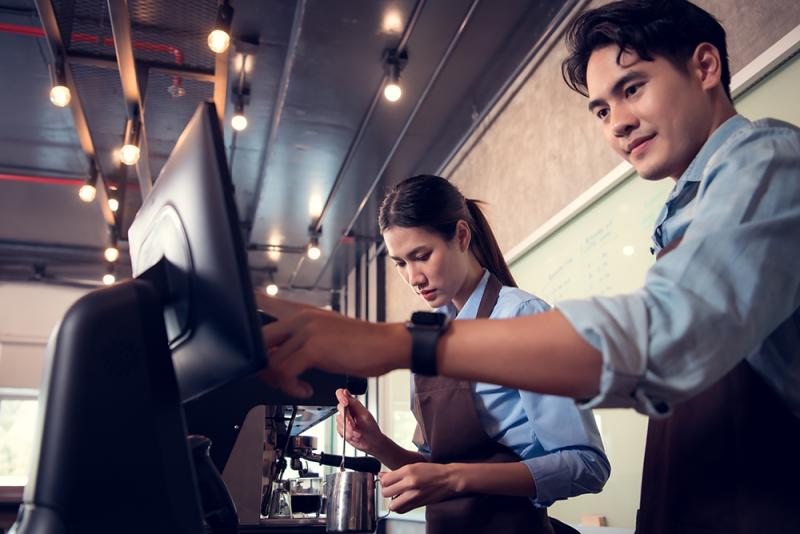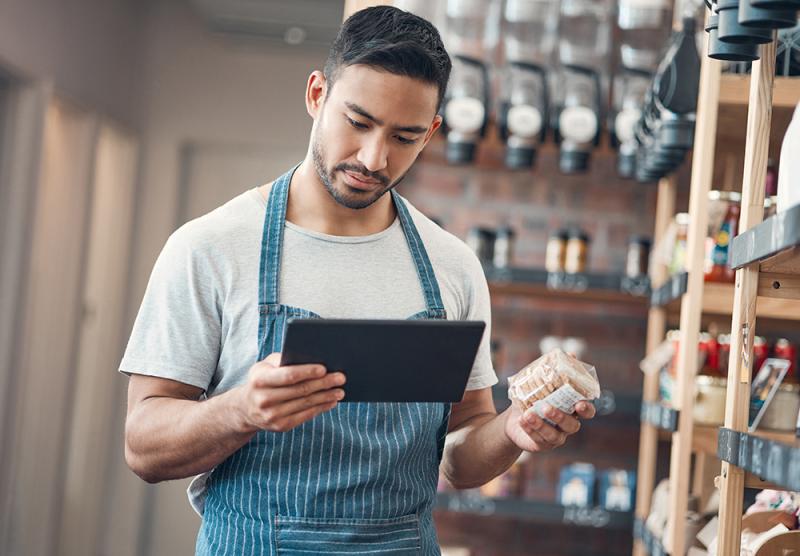Sometimes its what your customers and staff cannot see that will make a major impact on how successful your bar or restaurant will be in the long run. As the pendulum swings towards growth and innovation and away from survival, now is a good time to learn about technologies devised for the hospitality industry that accelerate efficiency, boost customer traffic, and improve staff morale—and which ones are worth integrating into your venue’s day-to-day operations.
The What & Why of Hospitality Tech
Let's start by taking a look at what technology is available and how it can benefit bars/restaurants.
Jason Wise, Chief Editor at EARTHWEB, provides expert opinions on how different industries use tech to improve sales, customer relations, and profitability. He offers his primer on what technologies are propelling bars and restaurants into the 21st century and beyond, along with the benefits.
Tech Options:
Mobile Ordering and Payments: Many bars and restaurants have implemented mobile apps or digital platforms that allow customers to place orders and pay directly from their smartphones. This not only streamlines the ordering process, but also reduces wait times and enhances operational efficiency.
Table Management Systems: Advanced table management systems are being widely adopted to optimize seating arrangements and reservations. These systems offer real-time updates on table availability, waitlist management, and even allow customers to reserve specific tables or request special accommodations.
Digital Menu Boards: Replacing traditional chalkboards or printed menus, digital menu boards enhance the visual appeal and flexibility of showcasing menu offerings. These boards can easily be updated, reducing printing costs and enabling businesses to highlight daily specials or make changes in real time.
Inventory Management Software: Technology-driven inventory management systems help bars and restaurants streamline their stock control processes. These solutions provide real-time updates on inventory levels, automate reordering, minimize waste, and ensure optimal stock levels for improved profitability.
Customer Relationship Management (CRM): Restaurants are leveraging CRM tools to gather customer data, enabling personalized marketing campaigns, loyalty programs, and targeted promotions. By understanding customer preferences and behavior, businesses can provide a more tailored experience, fostering customer satisfaction and loyalty
Benefits:
Enhanced Efficiency: With technology streamlining operational processes, businesses can optimize resource allocation, reduce manual work, and improve overall efficiency. This translates into faster service, accurate order fulfillment, and improved customer satisfaction levels.
Improved Customer Experience: Technology upgrades have significantly enhanced the overall customer experience. From convenient mobile ordering to personalized recommendations, customers can enjoy a seamless and tailored dining experience, increasing their likelihood of return visits.
Increased Revenue Opportunities: Advanced technology solutions enable data-driven decision-making, helping businesses identify opportunities for upselling, cross-selling, and targeted promotions. This, in turn, drives higher revenue and improves the bottom line.
Cost Savings: By automating various tasks and processes, businesses can reduce costs associated with labor, paper-based menus, and manual inventory management. Technology upgrades also minimize errors and theft, further increasing cost savings for establishments.
Doing Your Due Diligence on Tech
Owners should invest time in researching the apps, programs, gadgets, and other products that promise to improve business management and enhance customer experiences as a new economy takes shape.
Gabriel Rivera, Regional Director of F&B for Mehzcla at The Balfour Hotel in Miami, agree that the top technologies purchased by restaurants—the point-of-sale (POS) system, the table management system, and inventory/purchasing systems—are by default. More importantly, they’ve observed POS systems have evolved significantly since the pandemic, and now include such new features as virtual payment and virtual ordering. He also stresses the importance of keeping up with the times and updating your systems as upgrades become available for the technology chosen for a given venue.

“Tech solutions are an integral part of any well-managed operation, from reporting to order execution, inventory management, and marketing,” says Rivera. “However, while tech solutions contribute to operations, what you select for your restaurant really depends on the complexity of the operation and how you tailor the right tech to work for you. Thankfully, the rollout of technology in our industry has been simplified over the years, with tech companies offering everything from remote rollouts to onsite property experts who guide the property team through the process and post-implementation support.”
Angel Quiñones, CMO-COO of Borikuas Bistro, in Puerto Rico, also regularly evaluates the technologies she uses every three to six months to see how well it is working for the establishment. “It is important for us to invest in technology that allows us to do more with less, [especially as] our guests are more tech driven,” she says. When considering the integration of new technologies, she reviews recommendations from the developers. If she observes something already in use can be updated, she writes to the companies directly. “The feedback that we as users can give to product developers is very important for these technologies because they can improve to help us more every day.”
Rivera says that in the case of a restaurant within a hotel property like Mehzcla, it is critical to ensure that the technology integrates with the broader property management system. “This is the key feature we look for when making a decision on which technology to choose,” he says. "Once you narrow down your choices to those that do integrate well, then you evaluate which technology has the best support, is the most user-friendly, and provides the best set-up and reporting.
Brian Fountain, Director of Food & Beverage at Live! Casino & Hotel Maryland, also notes that as new products hit the open market, the team performs its due diligence to see which ones would be would a good fit for their operations and their guests. He adds he gets ideas from visiting trade shows, inviting vendors in to demonstrate the products, and staging focus groups to vet the need, cost, and return on investment.
“As technology continues to evolve, it only makes sense to keep on pace with it in the hospitality industry,” says Fountain, noting that order kiosks in their ‘Quick Service’ are in place and the property is finalizing an agreement to add mobile ordering options for beverages on the casino floor and to-go food at some of the restaurants. A “Robot Food Runner” is set to premiere at David’s Restaurant & Bar in August. “Our guests are becoming increasingly comfortable with all kinds of tech, and we want to offer whatever is available to improve their experience on property,” Fountain continues. “Any new rollout [involves] challenges, and we were initially faced with rough patches that we needed to work through with the new POS system and other improvements. However, it has proven to be a win-win, and our customers and team members express great satisfaction with the experience it provides.”
The Powerhouse of Tech: POS Systems
One of the most important pieces of tech in a bar/restaurant is the POS system.
“As I see it, our clients are folks who are running a restaurant business rather than just running a restaurant,” explains Liam Crooks, General Manager of Lightspeed, a platform used to streamline and unify point-of-sale/payments as well as help owners and managers use the data collected in the process to make informed decisions on menu items, promotions, and other business drivers beyond posts on review websites or social media. As Lightspeed has been adopted worldwide by multi-location restaurants, Michelin-star caliber restaurants (such as Chicago’s acclaimed Alinea), and lifestyle-driven eateries (London’s Silo and Crate, noted for its sustainability practices), he stresses the technology can be tailored for any establishment.
“One common customer frustration is that his server is nowhere to be found or disappears after he has asked for the check or put down a credit card to pay,” says Crooks, who speaks from experience dining out with his two energetic young children. “This is why a technology unifying payments and allowing customers and servers to do what they need to do by phone is a game-changer. Servers can either show you the bill or print it out, and a customer can pay and leave. While it had such a positive impact on the customer experience, its also had monumental impact for restaurants as tables can be turned over and new people seated efficiently.”
“We invest in technologies that allow us to achieve greater efficiency, reduce operating costs, and allow us to give our guests a unique experience,” says Quiñones, who details that Lightspeed POS, Lightspeed OrderAhead, and Lightspeed Loyalty are currently in use as are MM Call Button (a direct communication system connecting customers’ needs with the server, kitchen, and bar area); Draw Alive (keeping children of customers occupied on their phones and tables); and 7 Shifts (employee schedule management). BellaBot is being looked at for robots that will deliver food to the customers’ tables.

Crook adds that a POS system can improve more than the ordering and pay process thanks to the data it collects. As the data collected with Lightspeed provides management “real-life valuable data” showing what customers respond to, they can make changes to the menu, improve a recipe, or coach servers on getting word out about what’s actually the real customer favorites. As a result, what may seem like a “best-selling” cocktail may not actually boost the rate-of-return. Although it sounds great on the menu, is Instagrammable, or servers may be good at promoting it, it may not be that good of a drink. On the other hand, there may be a drink that’s a “hidden gem” on the cocktail list, but is ordered on repeat by guests who have tried it.
Using Tech to Cultivate the Guest Experience
Technology can also offer added novelty and interactive activity to a dining experience, even if operational tech is still being determined by management. For example, “heat-sensitive” menus at Hotel La Compañía's Exilio bar in Panama City has made the guest experience memorable, interactive, and distinctive. As Hotel La Compañía had been open for less than 18 months at press time, owner Chris Lenz predicts that hospitality technology will be introduced based on how operations-related needs arise and evolve.
“Our hotel is inside a restored Jesuit convent from 1688, and ceased operations in 1767 due to a secret order from King Carlos III to exile all Jesuits priests from New Spain,” says Lenz. “Our menus have this ‘secret order’ embedded in the menu, and when guests create friction by rubbing fingertips on the menu, they expose it. The technology brings the history of the building alive in a meaningful way. Although it’s too early to see how revenues have been affected, guests enjoy feeling like they are in a living museum. Moving forward, however, we need to listen and provide for [those] needs. If it is brand-driven by Hyatt, we will follow the mandated lead, and if it is driven by us or our customers, we will first determine if a given technology is compatible with our current systems. Our decision would be based on a point system where we make our own matrix of important issues/expected outcomes and rate each attribute of this matrix to come up with a tallied score to find the best suited product.”
Case Study: Okeydokey Miami
Okeydokey Miami, located in Miami’s Brickell neighborhood, provides a good case study of how technology can ensure a seamless customer experience and operation when the right applications and platforms are selected. Founder Stephane Benkemoun says the three-floor “lifestyle” venue incorporating five full-service restaurants, three bars specializing in craft cocktails, and a coffee shop, forms a “community-oriented environment,” and it is critical that all pieces of the equation adds up to something greater than the sum of its proverbial parts.
While technology was originally introduced to assist with the labor shortages, he says it continues to help maintain continuity with the flow and efficiency of his complex business.“We have invested in technology that facilitates paying, as well as ordering,” Benkemoun details.

He stresses that he does a lot of research and reads reviews to make sure the technology implemented falls in line with Okeydokey's vision. “Our guests are able to scan a QR code that leads them to PDF menus, inventory tracking, and payment options. Some of the most helpful technologies that Okeydokey utilizes are the Toast application to enable mobile payment, as well as scanning the menu QR code that also shows guests how many items they've ordered. Because the menu is digital, this allows us to have full freedom and control in the engineering of our restaurants’ menus. Similarly, the Toast application promotes efficiency within the staff by ensuring each worker is putting their efforts where needed. Lastly, the application also allows the restaurant to track its COGS (cost of goods sold) through inventory tracking software.”
Benkemoun acknowledges that the implementation process was very tedious, as he and his team wanted to ensure that every single function leant itself to the right command. Although the team was still learning how to best utilize the technology at this writing, he says that there is no doubt that once the adjustment period is over, this will ease their venue's systems though there will be occasions when some “older” types of service (ensuring there is a waiter at each table rather than just relying on the technology to order and interact) will be in place to ensure a personalized touch.
Although introducing new technology to your venue may not be a “plug-and-play” proposition, savvy owners can rest assured that implementing the right technology can keep other areas of your businesses moving forward.
Are you registered for our Crave and Crave on the Menu newsletters? Sign up today!
Plan to Attend or Participate in the 2024 Bar & Restaurant Expo, March 18-20, 2024
To learn about the latest trends, issues and hot topics, and to experience and taste the best products within the bar, restaurant and hospitality industry, plan to attend Bar & Restaurant Expo 2024 in Las Vegas. Visit BarandRestaurantExpo.com.
To book your sponsorship or exhibit space at the 2024 Bar & Restaurant Expo, contact:
Veronica Gonnello (for companies A to G) e: [email protected] p: 212-895-8244
Tim Schultz (for companies H to Q) e: [email protected] p: 917-258-8589
Fadi Alsayegh (for companies R to Z) e: [email protected] p: 917-258-5174
Also, be sure to follow Bar & Restaurant on Facebook and Instagram for all the latest industry news and trends.
